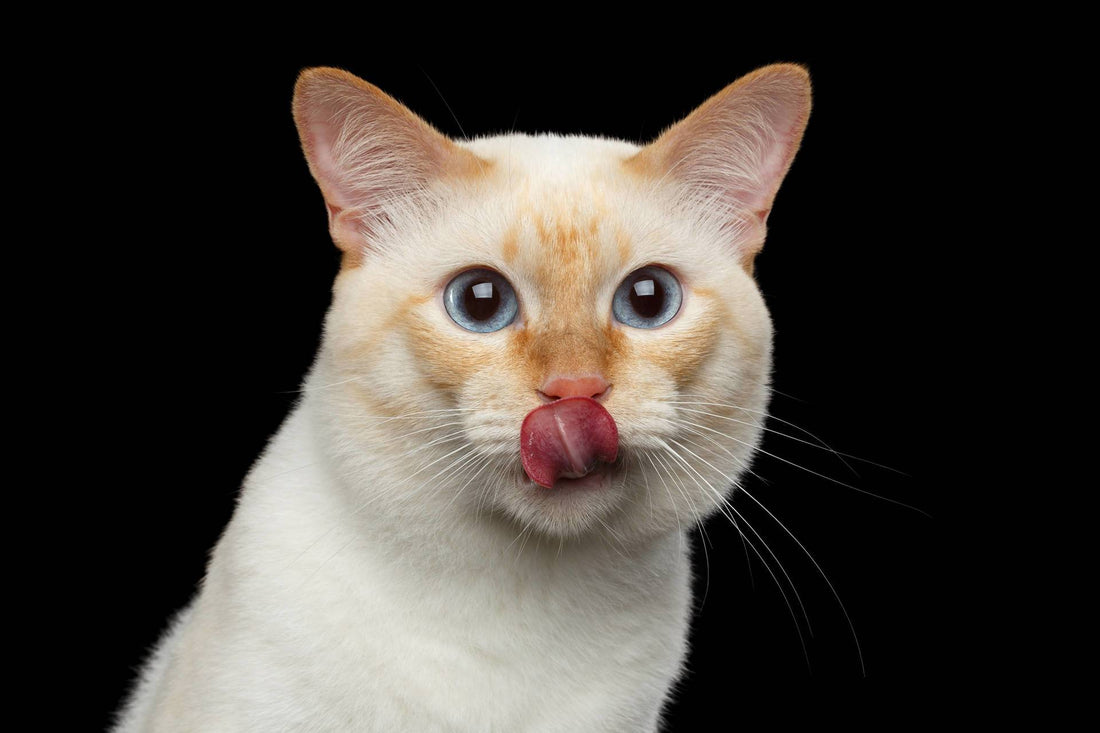Ever wonder how cats taste their food? They seem to have superpowers when it comes to climbing, stalking, hearing, smelling, and seeing. It makes sense that our feline friends might have an impressively fine-tuned sense of taste. We’re serving up a few surprises, so keep reading.
Cats Taste Food Unlike Any Other

Many people report that their cat companions have refined palates, and they wouldn’t be wrong, but many could be surprised at just what our kitties do and don’t taste.
Humans have about 9,000 taste buds! We can differentiate between sweet, sour, bitter, salty, and savory. It’s no wonder so much of our economy, time, and effort is centered around food. It’s not just one of our five senses. It’s a powerful, often underutilized function.
Cats, on the other paw, have a measly 470 taste buds. How can our kitties have a refined palette with so few taste buds? They eat with fewer taste sensations and a few extra powerful resources. As carnivores, kitties only need meat, so we know they taste savory. And we know they can taste sour and salty. It gets interesting when we find out our fur-babies experience bitterness in ways humans can’t, and they can’t taste sweets at all.
On top of a limited, but laser-focused set of taste buds, cats can taste in other ways we don’t even fully understand yet. Our furry felines have an additional organ called, the Jacobson organ. Combined with their sense of smell, this organ allows cats to experience taste in ways we cannot. Odors and scents are pressed against the roof of the mouth with the tongue, allowing our kitty to experience the essence of flavor and maybe even tastes we can’t comprehend.
The Bitter-Sweet Truth About Taste Receptors

While humans can enjoy both bitterness and sweet delights; cats can only taste bitterness. But their bitterness receptors are much stronger than that of humans. In fact, cats have 12 bitterness receptors, more than half of which are more active than ours.
Originally, scientists thought that bitterness would be something herbivores would taste better than anyone because they would need to detect plants that are safe and poisonous. But we now know that our carnivorous kitties have developed a strong sense of bitterness, allowing them to taste a diverse range of bitter compounds and concentrations.
Cats taste food differently than we do, and the fact that they can’t taste sweetness is probably the biggest piece of evidence. However, not tasting sweet flavors doesn’t mean they won’t like sweet food. They may not be able to taste sugary sensations, but they will experience sweet flavors differently, such as in texture and scent.
It is thought that because cats are carnivores, they have no need for carbohydrate-rich sugars, so the gene that detects sweet flavors became obsolete and was evolved out of their genetic code. Being able to detect protein-rich foods that are nutritionally important would be why their bitterness and savory senses are heightened.
Fun Facts About How Cats Taste Food
Food temperature is important to cats. It’s thought that their preference for warmer food, 100 degrees Fahrenheit, more closely resembles freshly killed prey.
 One of the most important factors in cat health and nutrition is their ability to digest their food. However, commercial pet food is often difficult for cats to digest because they lack the essential enzymes to get the full benefit of their food. EcoDigestive probiotic and enzyme support formula from Vet Organics is the perfect supplement for happy healthy cats.
One of the most important factors in cat health and nutrition is their ability to digest their food. However, commercial pet food is often difficult for cats to digest because they lack the essential enzymes to get the full benefit of their food. EcoDigestive probiotic and enzyme support formula from Vet Organics is the perfect supplement for happy healthy cats.
We can use our understanding of how cats taste food when training a new fur baby. To help deter licking, chewing, and scratching, we can spray a little bitter scent on the area that we want them to avoid. Consider known cat repellents, such as citronella, eucalyptus, and citrus.
Consistency is just as much a part of how cats taste food as it is for humans. Our furry felines are known for preferring kibble in large pieces, rather than crumb-size and they prefer soft food over hard food.
 Shape probably plays a role similar to consistency and texture. Our kitty-companions have been tested for preferences and they tend to prefer shape variety. If we are going to give them kibble, the shapes should vary week-to-week to keep their interest alive and avoid falling prey to finicky cat tendency for rejection.
Shape probably plays a role similar to consistency and texture. Our kitty-companions have been tested for preferences and they tend to prefer shape variety. If we are going to give them kibble, the shapes should vary week-to-week to keep their interest alive and avoid falling prey to finicky cat tendency for rejection.
So, even though cats have markedly fewer taste buds and can’t taste sweets, we do know that our felines may be finicky eaters because they experience heightened bitterness. And because of their Jacobson organ, cats taste food and may experience taste sensations for which we don’t even have names. We also know that texture, genetics, and instincts go a long way to determine how our cats perceive and enjoy their dining experience.
What is your cat’s favorite treat? Share your answers, recipes, and cat companion pictures with us on social.
Further Reading:
- "Nutrition- Feeding Guidelines For Cats," VCA Animal Hospital
- "5 Cool Facts About Your Cat's Sense of Taste," Catster
- "Do Foods Taste The Same To Animals As They Do To Us," MNN Earth Matters


